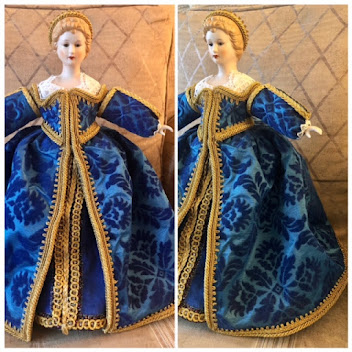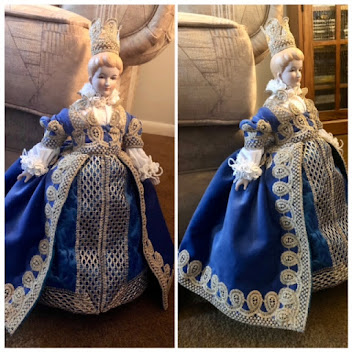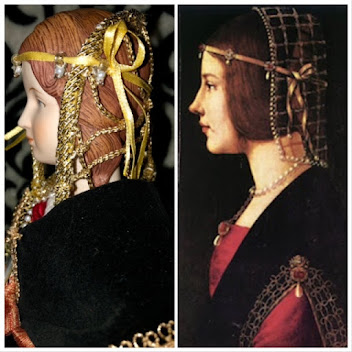 |
| Courtesy of V& A Museum, London |
I originally started this particular research for this project in 2014. At that time, I made an elaborately embroidered ladies' waistcoat inspired by the late 16th-century ones found in museums. This project was completed with the limited skill set I had at the time. Also, consider it an accomplishment that I completed the waistcoat and it is a wearable item. Although in viewing the project through a different lens, regarding technical sewing and embroidery, this project was a hot mess from a historical representation standpoint. I learned so much working on that project I don't consider it a failure. It was a lesson as are people who come in and out of your life, this project was a husband ago and I was a much different person then than I am now.
 |
| Courtesy of V& A Museum, London |
So in 2014 I was going to make another embroidered waistcoat but wanted to find one from the few extant ones that inspired me. Especially since I was going to really focus on one extant example and do it to the best of my ability. Period correct materials, techniques, and all the accuracy I could muster. As life has a way of doing I put the project in its infancy research stages aside. Other projects took precedence and years since fashion dolls became my focus. So this has been waiting in the wings for the past 8 years. What brought this up again is a pending trip to London UK in the spring of 2023. After marrying my current husband we had planned on visiting London as a honeymoon since he lived there for 10 years. Want him to show me around to his places like his university, some tourist sites, and favorite restaurants and maybe meet up with old friends of his. What better than making an appointment at the Victoria & Albert Museum to see item T124.1938. It's not on display but in their inventory.
 |
| Courtesy of V& A Museum, London |
During that year in 2015, I want to make an embroidered waistcoat and a friend researching the topic happen to find one that is red wool embroidery on linen woolsey fabric dated from 1630. My friend THL Elizabeth De Salisbury in the Kingdom of Ansteorra made a polychrome version with goldwork in the style of the Layton Waistcoat with an embroidery design based on Christie's panel. I am impressed with her work on this project which took 3 years to complete, and it really came out like the original piece from the period. While this one I am considering reproducing is much later. I don't mind journeying into the realm of the early 17th century, as the SCA covers fencing and some other activities that were more at height in the early 17th century.
 |
| Courtesy of V& A Museum, London |
Linsey Woosey is a fabric that is linen warp and wool weft to create a blended fiber fabric. This happens to be the ground fabric that is the basis of this lady's embroidered waistcoat. The article regarding this waistcoat describes the fabric as coarse in texture. Although with the embroidery I can see this being used for strength in the finished garment but also supporting the stress of being embroidered. At this time there are also wool and cotton blends that exist doing the same arrangement; linen warp, and cotton weft. Those are more popularly called fustian also can be made of wool too. I have such an appreciation for this detail, from having woven my own fabrics. While it would be nice to weave my fabric for this project. I feel a tighter finished product could be achieved from a commercially made fabric. I was able to locate the correct fabric for this project which will be $45 a yard. As it is still used as an interlining for modern suits. Although at this point I need to see what amount I will need to purchase for this project. Although I am not thinking more than 3 yards. I plan on making a coif to match my final garment but will be embroidered first as my sample piece.
 |
| Courtesy of V& A Museum, London |
The embroidery style is one of the ways that the museums are able to date this piece of clothing. The V&A has this waistcoat listed from 1630 and has animals and plants arranged on the jacket in a repeat order. Unlike the earlier waistcoats of the late 16th century, there are not any vining or trailing designs. The change in the way the embroidery is arranged on this particular waistcoat. In my opinion, aids in bridging the gap between 16th-century gold and polychrome silk embroidery to Jacobean crewel work embroidery. I have included images of the animals for the enjoyment of the handwork that was made on this garment. I am considering if the embroidery threads were not just wool but also linen. So I am planning on having both available when I start ordering threads for this project.
 |
| Courtesy of V& A Museum, London |
The pattern shapes of the waistcoat garment do tell a story in the life of this piece. Which is this waistcoat was altered to fit another wearer later in the 17th century. This was common practice to have clothing remade or refashioned as the fabric was expensive. Clothing was a commodity and there was a very lucrative second-hand clothing market historically more so than there is today. Also, this being an embroidered garment would mean it still had value. Even if it was out of style enough to have the seams picked and reworked into a fashionable shape. I am taking these facts from the article written by the museum about this waistcoat. Luckily it does appear in one book that is still able to be purchased. So my Amazon gift cards from rewards at my work accumulated enough to order two books at a good discount for 17th-century clothing to add to my collection from this period.
 |
| Courtesy of V& A Museum, London |
The time frame of the 17th century seems to also have a narrow amount written about the clothing and material culture of clothing. I like the earlier part of the century, the fashion from 1600-1650 at the latest. Both my 16th-century clothing pattern books fit on one bookshelf with my 17th-century fashion books, some of which also have patterns. Not to say that there is no bookshelf for embroidery, one for Lace, one for theater clothing, and three shelves for books on dolls, doll houses, and miniatures. Well, there is enough for a well-curated crafting library in my basement. Which I hope can have a proper place of glory sometime in the future. A dedicated real-life library in a large house is very much needed.
 |
| Courtesy of V& A Museum, London |
The garment you are looking at has some linen tape on the inside of the sleeve cuffs, collar, and front closure area. Basically, all the parts of a garment that be strained from consistent wear. I find it interesting it is not lined to better aid in the long-term survival of the garment. Although it does provide a unique opportunity to look into the construction techniques. Specifically, the stitches used for the embroidery, a good look at the back of the embroidery, and the garment construction stitches can be determined easier than from just the front. Also, I can check seam treatments of any kind and look at how the reworking was done for the later alternation of this garment. I am so excited if you can't tell to get to finally meet this lovely lady's waistcoat in person. To take a first-hand observation of the garment, measurements, and work out the pattern of the embroidery elements. Possibly with permission take some interior seam photos.
Regarding the images of the waistcoat in this blog. These images are shared with the distinct purpose of educational enrichment and are to not be distributed for any commercial purposes. Please visit the museum's website for further details regarding their licensing of images for educational use.
Excited,
Marrin













No comments:
Post a Comment